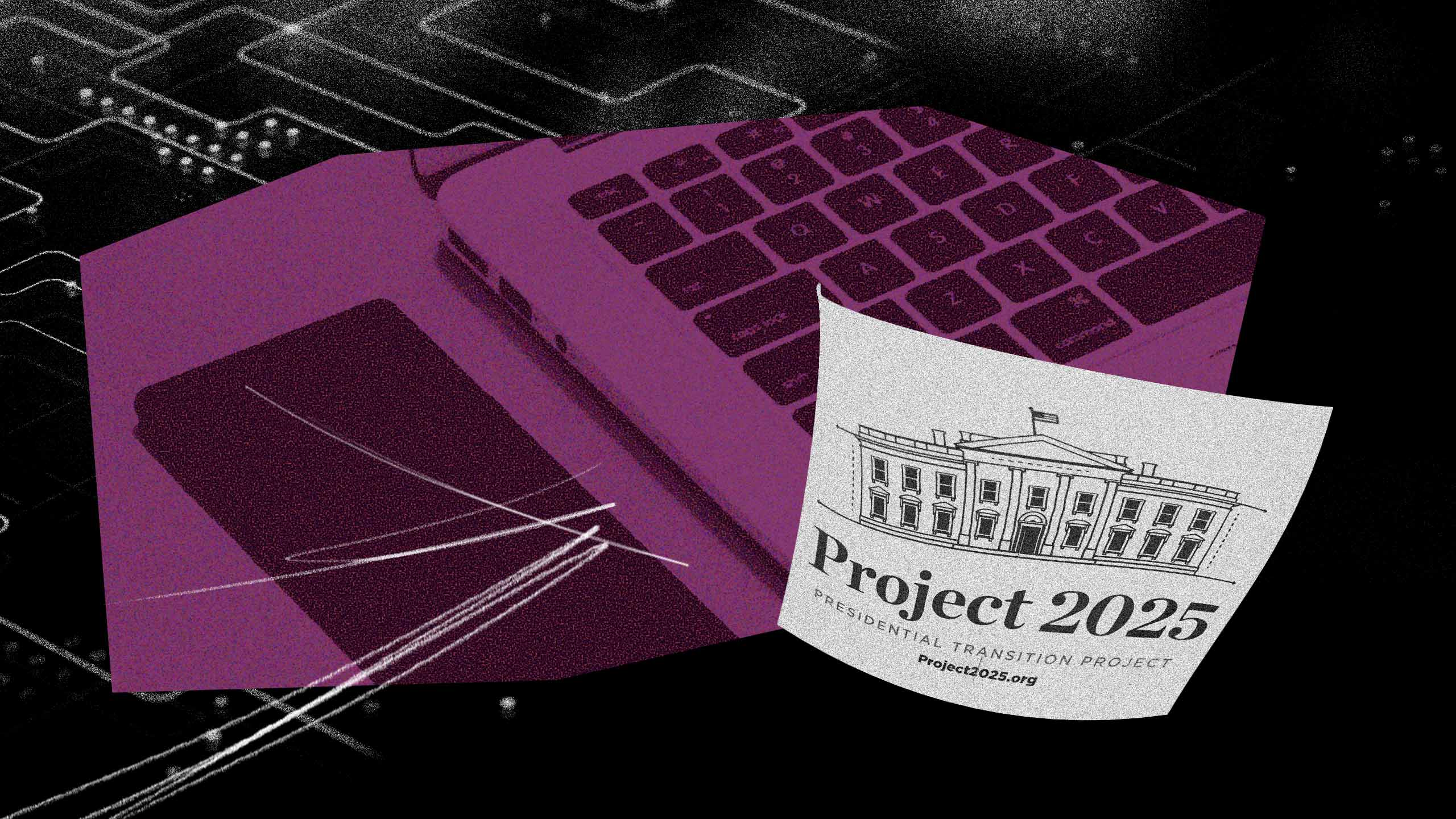What you are about to read is pornographic. Granted, it’s not very hot, or even sexually explicit; I don’t think the world needs that energy from me. Yet, because I am a trans person, and because I am writing about trans people, this article likely meets the definition of “pornography” as laid out under Project 2025, the Heritage Foundation’s blueprint for the second Trump administration.
Under that definition, “pornography” is—or will be—a criminal offence. “Pornography, manifested today in the omnipresent propagation of transgender ideology and sexualization of children … has no claim to First Amendment protection,” writes Kevin Roberts, president of the Heritage Foundation, in the document’s introduction. “Pornography should be outlawed. The people who produce and distribute it should be imprisoned. Educators and public librarians who purvey it should be classed as registered sex offenders. And telecommunications and technology firms that facilitate its spread should be shuttered.”
This is an unmistakable call to criminalize queer media and lock up those who produce it. Banning porn—as in, porn-porn, the kind with pictures of naked people—is certainly on the table, and even has conservative support behind it. Gallup finds that only 38 percent of Americans believe porn is “morally acceptable,” and the groups most opposed to porn’s existence are “people over 55, people who didn’t finish college and conservatives”—meaning, as per Ryan Teague Beckwith at MSNBC, that “banning porn would be popular with Trump’s voter base, and unpopular with everyone else.”
Yet the real problem with this passage is its slippery use of “pornography,” conflating it with conservative buzzwords and dog whistles like “transgender ideology” and “the sexualization of children,” used by groups like Moms for Liberty to denote any media that so much as acknowledges queer and (especially) trans people’s existence. As Melissa Gira Grant writes in The New Republic, “Project 2025 is not targeting ‘pornography’ as something that’s harmful to children per se, but rather redefining anything concerning sexuality and gender that they say is harmful to children as pornography.”
Trump distanced himself from Project 2025 during his campaign, but his administration is now openly hiring from its roster—including Trump’s pick for FCC chair, Brendan Carr, who would be in a position to execute some of the most damaging changes. It’s a nightmare scenario that recalls some of the most violent chapters of queer history. (Once you’ve seen one Hirschfeld library burn, you’ve seen ’em all.) Yet, scary as this is, it’s important not to let fear do our thinking for us—we need a realistic picture of the situation so that we can plan to survive it. Here is a timeline and strategy guide for the crackdown.
Don’t comply in advance
The most dramatic scenario—someone coming in, shutting all the lights off and tossing every queer writer in jail—isn’t the most likely one. The suppression of trans voices is more likely to be a gradual process that relies largely on people’s risk avoidance and sense of self-preservation. We know this, because it’s been going on for some time.
The news that Trump was suing the New York Times and Penguin Random House for unfavourable coverage recently generated a lot of panic on my own social media timeline, for example, but Trump has sued or threatened to sue just about every news organization that has ever covered him. He’s suing CBS News for airing an interview with Kamala Harris. He’s suing ABC News for saying that “courts have found him liable for rape,” which they have. He’s sued the New York Times on multiple occasions.
This certainly sends a message, in that it shows journalists that the administration is hostile, but the problem is not that Trump might put the New York Times out of business. It’s that smaller publishers, who can’t afford legal battles, will be less willing to publish content that puts them on Trump’s enemies list. We have already seen some outlets “complying in advance”—the Jeff Bezos-owned Washington Post, for instance, refused to run its presidential endorsement of Kamala Harris for fear that Trump might retaliate if he won.
Similarly, book bans are nothing new—and publishers still sell banned books. Some obvious potential models for censorship under a Trump administration, according to PEN’s Freedom to Read program director Kasey Meehan, are Florida’s “Don’t Say Gay” legislation, which makes it illegal for teachers to mention queer and trans existence; or various state-level “parental rights” bills that give parents the ability to restrict their children’s access to information.
“The concern with the Trump administration is that many of the tactics that we’ve seen play out locally and at the state level to censor those identities, to censor stories of queer and trans people—we’ll see that jump to a federal level,” Meehan tells Xtra. “We’ll see, potentially, the secretary of education use similar rhetoric that has intimidated school districts away from having diverse and inclusive library collections.”
Scary as this is, it’s only ramping up a process that is already ongoing. Numbers of book bans have tripled in the past year alone. They increasingly target public libraries, rather than school libraries—the point is no longer keeping queer books away from children, it’s about making sure that no one has access to them. Libraries that refuse to comply can have their funding slashed or even be closed, meaning that the attack on queer and trans literature is also an attack on the whole community’s access to learning.
That’s the bad news. The good news is that, even in this climate, publishers are still willing to take on the risk of publishing and marketing queer books. Rainbow capitalism dictates that they’ll keep offering us book deals as long as those books keep selling, and controversy can often raise a writer’s profile. In some cases, like Maia Kobabe’s Genderqueer, being targeted has actually boosted a book’s sales.
Again, though, the chilling effect is real. Librarians who stock queer and trans materials are increasingly subject to bomb threats and harassment, as are queer authors. The price of visibility is sanity, and for many people, it’s just not worth it. Similarly, if publishers get the sense that the risk outweighs the reward, they will stop publishing trans people.
For right now, though, the course of valour is to stay as loud as possible, for as long as possible and to cede no ground—no one can shut you up without your consent. At least not until they can.
The internet might be the first to go
Bethany Karsten, editor-in-chief of The Transfeminine Review, has written an excellent and exhaustive guide on how to preserve queer and trans literature in the event of widespread censorship. According to Karsten, the internet will be significantly more vulnerable than traditional publishing, at least in the early stages.
One way Trump has already moved to enact Project 2025 is in his pick of the FCC chair Brendan Carr. Carr wrote the chapter on the FCC in Project 2025, and as chair, he would be in a position to enact at least some of the criminal sanctions proposed—specifically, the bit about shuttering telecommunications firms that allow queer and trans voices to proliferate. The way he could do this is to gut Section 230 of the Communications Decency Act, which would make it an intolerable legal risk for internet platforms to host content by queer and trans people.
“Section 230 basically holds that internet platforms can’t be held liable for the speech acts of their users, barring some criminal exceptions,” Karsten tells me. “Project 2025 has a twofold strategy for purging the trans internet—they want to expand that exception to include gender nonconforming speech as ‘grooming,’ and then they want to rewrite Section 230 to make Google and Apple and all liable for platforming anything that falls under that new definition of ‘grooming.’ So it wouldn’t matter what the content of the trans speech was: Big Tech would pre-emptively remove all queer speech from their platforms to avoid getting sued into oblivion by the federal government.”
Again: Bans on digital speech are not new, and many of them are enacted under the pretence of “protecting” women or children. Sex workers’ digital speech has been largely criminalized by SESTA-FOSTA, which holds platforms liable for hosting their content. Queer advocates spent most of last year protesting KOSA, the “Kids’ Online Safety Act,” which would make it illegal for platforms to host content that “endangers” kids’ mental health (again, in the minds of the people designing the bill, letting children know that trans people exist endangers them).
Both KOSA and SESTA-FOSTA received bipartisan support—Kamala Harris supported both of them, for example—which means that, if and when internet censorship starts, Democrats are unlikely to do much to resist it. This is where I give you licence to freak out, or at least, to put your worst-case scenario plan together. It is smarter to bank on the worst than to hope for the best, even if you’re wrong.
Create the new underground
The potential loss of the internet is devastating precisely because it has traditionally been an outlet for queer people who don’t have Big Five publishing deals or traditional media platforms. The most well-known and marketable trans writers may well survive this era of censorship, but without that underlying hum of queer conversation and creativity, trans culture will be significantly less vital and diverse.
Karsten says trans people—one of the most online demographics—will need to become significantly less online in their media creation and distribution to survive this era. Social media chatter will need to give way to real-world community-building. Newsletters and blog posts may need to become zines and pamphlets; that’s what they were in the ’90s, or in the French Revolution, for that matter, and it seemed to work out. Books will need to be bound and printed: If you keep all your queer literature on your Kindle, for example, it’s entirely possible that Amazon can erase banned books from your library without warning or consent.
This switch to the physical and small-scale leads to one of Karsten’s more beautiful suggestions—the microlibrary, a personal cache of banned or about-to-be-banned materials that can be kept in waiting until better days. It’s an eminently accessible form of activism; if you’re reading this, odds are that you already have a collection of zines or books by trans people, which you can build on. You may also have normie cis friends who are willing to host a box in their attic or garage; the more widely distributed the library is, the better the chance of its survival.
This, too, is not a new suggestion: “That’s how books were circulated for the vast majority of human history,” Karsten says, and it’s often how social movements built support. The abolition of slavery was furthered by “anti-slavery reading rooms” in northern states, like the one founded by Harriet Jacobs. Support for overturning obscenity laws in publishing only arose after it became a literary status symbol to own smuggled-into-the-country copies of books by James Joyce, D.H. Lawrence and Henry Miller.
Say what you will, but we are definitely living through a historic moment for trans people—and the future will want to hear who we were and what we did to survive it. Writing matters. Reading matters. Documenting your own unremarkable trans life in a journal matters; historians’ accounts have often hinged on less. Collecting trans literature and keeping it safe is a quiet, low-profile, profoundly important way to preserve our voices and let them touch the future. The Trump administration will pass, because everything passes. Trans people will still be here, and so will our art. When we write, we’re speaking to that better world.


 Why you can trust Xtra
Why you can trust Xtra


